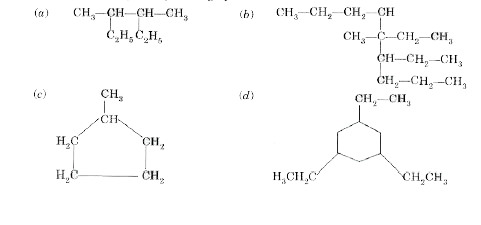The correct Answer is:C
To solve the reaction of H₂C(CH₃)(CH)=CH₂ with HBr, we will follow the mechanism of electrophilic addition. Here’s a step-by-step breakdown of the reaction:
Step 1: Identify the Reactants
The reactant is H₂C(CH₃)(CH)=CH₂, which is an alkene. The alkene has a double bond between the carbon atoms, making it a site for electrophilic attack.
Hint: Recognize that alkenes are reactive due to the presence of a double bond.
Step 2: Electrophilic Attack
When HBr is added to the alkene, the H⁺ from HBr acts as an electrophile and attacks the double bond. The double bond between the carbon atoms breaks, and one of the carbon atoms forms a bond with the hydrogen atom.
Hint: Electrophiles are species that seek electrons and will attack regions of high electron density, like the double bond in alkenes.
Step 3: Formation of Carbocation
As the H⁺ attaches to one of the carbon atoms, a carbocation is formed on the adjacent carbon atom. The stability of the carbocation is crucial; in this case, a secondary carbocation is formed, which is more stable than a primary carbocation.
Hint: The stability of carbocations increases with the number of alkyl groups attached to the positively charged carbon.
Step 4: Nucleophilic Attack by Bromide Ion
The Br⁻ ion, which is the nucleophile from the dissociation of HBr, will then attack the positively charged carbocation. This results in the formation of the final product.
Hint: Nucleophiles are species that donate electrons and will attack positively charged centers, such as carbocations.
Step 5: Final Product
The final product of the reaction will be a bromoalkane, specifically 1-bromo-2-methylpropene.
Hint: Always check the structure of the final product to ensure that it matches the expected outcome based on the mechanism.
Summary of the Reaction
The overall reaction can be summarized as:
H2C(CH3)(CH)=CH2+HBr→1−bromo−2−methylpropene
Final Note
Understanding the mechanism of electrophilic addition, including the formation of carbocations and the role of nucleophiles, is key to predicting the products of reactions involving alkenes and hydrogen halides.
---
The reactant is H₂C(CH₃)(CH)=CH₂, which is an alkene. The alkene has a double bond between the carbon atoms, making it a site for electrophilic attack.
When HBr is added to the alkene, the H⁺ from HBr acts as an electrophile and attacks the double bond. The double bond between the carbon atoms breaks, and one of the carbon atoms forms a bond with the hydrogen atom.
As the H⁺ attaches to one of the carbon atoms, a carbocation is formed on the adjacent carbon atom. The stability of the carbocation is crucial; in this case, a secondary carbocation is formed, which is more stable than a primary carbocation.
The Br⁻ ion, which is the nucleophile from the dissociation of HBr, will then attack the positively charged carbocation. This results in the formation of the final product.
The final product of the reaction will be a bromoalkane, specifically 1-bromo-2-methylpropene.
The overall reaction can be summarized as:
H2C(CH3)(CH)=CH2+HBr→1−bromo−2−methylpropene
Understanding the mechanism of electrophilic addition, including the formation of carbocations and the role of nucleophiles, is key to predicting the products of reactions involving alkenes and hydrogen halides.
Topper's Solved these Questions
- HALOALKANE AND HALOARENESBook:NARAYNAChapter:HALOALKANE AND HALOARENESExercise:EXERCISE - 4
Explore 59 Videos
- HALOALKANE AND HALOARENESBook:NARAYNAChapter:HALOALKANE AND HALOARENESExercise:EXERCISE - II (H.W)
Explore 28 Videos
- F-BLOCK ELEMENTSBook:NARAYNAChapter:F-BLOCK ELEMENTSExercise:CHECK YOUR GRASP
Explore 2 Videos
- HALOGEN COMPOUNDSBook:NARAYNAChapter:HALOGEN COMPOUNDSExercise:Passage 13
Explore 1 Video
Similar Questions
Knowledge Check
CH3−C∣CH2H−CH=CH2+HBr→A (predominant), A is
ACH3−C∣CH3H−C∣BrH−CH3BCH3−C∣CH3H−CH2−CH2BrCCH3−Br∣C∣CH3−CH2−CH3DNone of the aboveH3C−CH∣CH3−CH=CH2+HBr→A.
A is predominantlyACH3−CH∣Br−CH∣CH3−CH3BCH3−CH∣CH3−CH∣Br−CH3CCH3−CH∣CH3−CH2CH2BrDCH3−Br∣C∣CH3−CH2CH3The IUPAC name of C∣CIH2−C∣CH3=CH−CH2OH is:
A4-Chloro-3-methylbut-2-en-1-olB1-Chloro-2-methylbut-2-en-4-olC4-Chloro-1-hydroxy-3-methylbut-2-eneD1-Chloro-4-hydroxy-2-methylbut-2-ene
Name the following compounds accoring to IUPAC system :
(i) CH3−CH2−CH∣CH2Cl−CH2OH∣CH−CH∣CH3−CH3(ii)CH3−CH∣CH3−CH2−CH∣OH−CH2OH∣CH−CH3
(iii) (iv) H2C=CH−CH∣OH−CH2−CH2−CH3
(iv) H2C=CH−CH∣OH−CH2−CH2−CH3
(v) CH3−C∣CH3=C∣Br−CH2OH
View SolutionWrite down the IUPAC names of the following compounds :-
(A) CH3−CH∣C2H5−CH3∣CH−CH∣OH−CH3
(B) CH2=CH−CH∣CH2−OH−CH2−CN
(C) CH3−CH2CH3∣C∣CH3−C(CH3)3
(D) CH3−CH∣CN−CN∣CH−CH2−CH3
(E) CH2=CH−CH∣C≡C−CH3−CH2−CHO
(F)
(G) CH2=CH−CH∣CH3−C≡CH

View SolutionWrite IUPAC name of the following compound
(a) CH3−CH2−CH∣CH3−CH2CH∣CH2−CH3−CH2−CH2−CH3
(b) CH3−CH3∣C∣CH3−CH2−CH2−CH3∣CH−CH2−CH∣CH3−CH3
(c)_S01_012_Q01.png)
View SolutionThe IUPAC name of the following compound
H3C−CH2−CH∣CH2CH3−CH2−CH∣CH3−CH2CH3 is:
View SolutionCorrect name for the given compound
CH3−CH2−C∣CH2CH3H−CH2−C∣CH3H−CH2−CH3 is
View Solution

